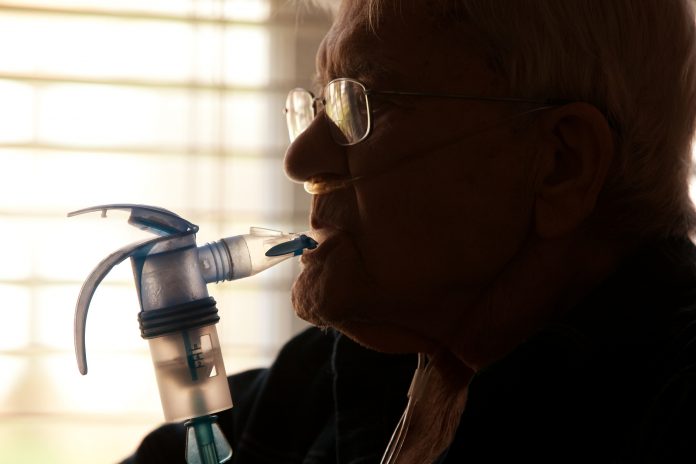
To make lung cancer screening more readily available in low-resource settings, researchers at MIT have developed a urine-based point-of-care test using inhaled aerosolized nanosensors that are delivered to patients by an inhaler or nebulizer. If the sensors encounter cancer-linked proteins in the lungs, they produce a signal that accumulates in the urine, where it can be detected with a simple paper test strip. A paper describing the technique, known as PATROL (point-of-care aerosolizable nanosensors with tumor-responsive oligonucleotide barcodes) is published in Science Advances.
The current mode of screening for lung cancer, low-dose computed tomography (CT), is resource-intensive. To improve diagnostic access worldwide, a team from the MIT lab of Sangeeta Bhatia has been developing sensors called activity-based nanosensors, or ABNs.
“ABNs are nanoparticles that are responsive to proteases,” explains co-first author Edward K.W. Tan, PhD, formerly a postdoctoral fellow in the Bhatia lab. “We wanted to apply this technology to detect lung cancer at a much earlier stage and realized there is a significant advantage of using inhalation to deliver ABNs. With inhalation, the ABNs are immediately delivered to the lung and the site of any tumor, and we found it to be very effective and easily deployable, especially in a low-resource setting.”
ABN sensors consist of a core nanoscaffold conjugated to a DNA barcode through a linker. The linker is a synthetic peptide that can be cleaved by proteases when encountered at the tumor site.
“The cleavage leads to shedding of the DNA barcodes into the circulation and eventually concentrated in the urine where it is expelled ,” explains co-first author Qian Zhong of the Bhatia lab.
In this study, the team probed the Cancer Genome Atlas to survey which proteases are highly dysregulated in lung cancer from early to late stages. They ultimately selected 20 target proteases identified as key players in early-stage lung cancer patients.
In their first set of tests in preclinical mouse models, the team dosed the animals with a cocktail of 20 nanosensors to provide a fingerprint that correlated with the excreted barcodes. In their next experiments, they had to choose only four sensors likely to give the most accurate results, since their device’s design capacity is currently limited to detect up to four different DNA barcodes, each of which indicates a different protease. To identify these four sensors, the team used machine learning algorithms to rank those top 20 sensors.
To detect the barcodes, the researchers developed a point-of-care lateral flow assay, much like a typical pregnancy or COVID test which allows the barcodes to be detected using a paper test strip.
No pre-treatment or processing of the urine sample is required. The test needs only a few drops of urine and the results can be read about 20 minutes after the sample is obtained. A portable device with built-in software reads the lateral flow assay, providing information on whether the patient has a high risk of cancer, no risk or low risk.
In this study, the researchers showed that using the four selected ABNs in mouse models accurately detected early-stage lung cancers.
Looking ahead to potential use in humans, the researchers first must prove the safety of ABNs. They also realize that the test may necessitate using more than just four sensors.
“The human is much more complicated than mouse so we will likely need more than four sensors—maybe eight or 12,” says Zhong. “But the beauty of our design is that every single paper (strip) can detect four; we can just use more strips in future devices and still it will only require a few microliters of urine, just a few drops.”
The test may also have other applications as well. “I can see tailoring it to different diseases, even different stages of lung cancer,” adds Tan. “It is a plug-and-play model design using ABNs. You just need to understand the underlying protease biology.” He also foresees this technology may have application in monitoring treatment responses as a non-invasive test for disease progression or drug efficacy.











